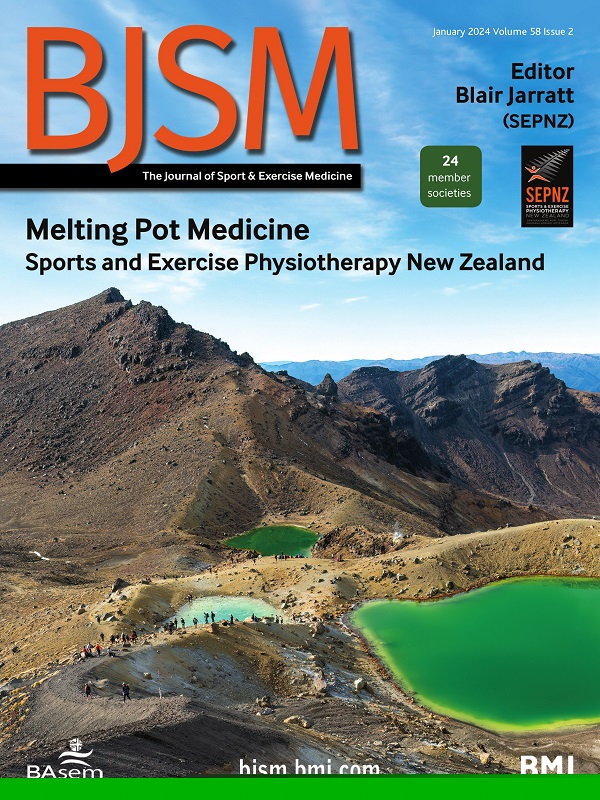Development and validation of the Wisconsin Sport Specialization Questionnaire (WISSQ) for older adolescent athletes.
IF 11.6
1区 医学
Q1 SPORT SCIENCES
引用次数: 0
Abstract
OBJECTIVE The proliferation of youth sport specialisation may be concerning for the overall health of adolescent athletes, but no validated tool to measure specialisation exists. We aimed to assess the measurement properties and validate the Wisconsin Sport Specialization Questionnaire (WISSQ) in older adolescent athletes. METHODS Using previously developed sport specialisation items with established content validity, questionnaires were administered to 14-18-year-old athletes residing in both regional and national settings, who were participating in organised sport. Confirmatory factor analyses and Rasch partial credit modelling independently assessed structural and concurrent validity and reliability in both datasets. The best-fitting national model was then fit onto the regional data to further assess the stability of the measurement properties. RESULTS The regional and national data included 474 (77% female, 86% non-Hispanic White) and 564 (38% female, 63% non-Hispanic White) athletes, respectively. Twelve of 25 items were retained in three domains (n=4 social, n=5 motivation, n=3 physical). One item cross-loaded on both the motivation and physical domains. The adapted regional (comparative fit index (CFI), 0.97; Tucker-Lewis index (TLI), 0.97; root mean square error of approximation (RMSEA), 0.04) and national (CFI, 0.99; TLI, 0.99; RMSEA, 0.05) datasets achieved good model fit. Internal consistency among the three subdomains ranged from Ω=0.78-0.88 (national) to Ω=0.73-0.83 (regional). All items contributed appropriately to measuring the construct of sport specialisation in the regional (infit/outfit: 0.77-1.16) and national (infit/outfit: 0.74-1.16) datasets. CONCLUSIONS We present the first validated tool to measure youth sport specialisation while considering physical, motivational and social characteristics of sport participation. The WISSQ is a valid, reliable assessment of sport specialisation in older adolescent athletes.针对老年青少年运动员的威斯康辛体育专业问卷(WISSQ)的开发与验证。
目的青少年体育专业化的发展可能与青少年运动员的整体健康状况有关,但目前还没有有效的工具来衡量专业化。我们的目的是评估测量性质和验证威斯康星体育专业化问卷(WISSQ)在年龄较大的青少年运动员。方法使用先前开发的具有确定内容效度的体育专业项目,对居住在地区和国家的14-18岁参加有组织体育运动的运动员进行问卷调查。验证性因子分析和Rasch部分信用模型独立评估了两个数据集的结构和并发效度和可靠性。然后将最佳拟合的国家模型拟合到区域数据上,进一步评估测量特性的稳定性。结果地区和国家数据分别包括474名运动员(77%为女性,86%为非西班牙裔白人)和564名运动员(38%为女性,63%为非西班牙裔白人)。25项中的12项被保留在3个领域(n=4个社交领域,n=5个动机领域,n=3个身体领域)。一个项目在动机和物理领域交叉加载。适应区域比较拟合指数(CFI)为0.97;Tucker-Lewis指数(TLI), 0.97;近似均方根误差(RMSEA), 0.04)和国家(CFI, 0.99;, TLI 0.99;RMSEA, 0.05)数据集获得了良好的模型拟合。三个子域的内部一致性范围从Ω=0.78-0.88(国家)到Ω=0.73-0.83(地区)。所有项目都对测量区域(infit/outfit: 0.77-1.16)和国家(infit/outfit: 0.74-1.16)数据集的体育专业化结构做出了适当的贡献。我们提出了第一个有效的工具来衡量青少年体育专业化,同时考虑体育参与的身体,动机和社会特征。WISSQ是对年龄较大的青少年运动员的运动专业化进行有效、可靠的评估。
本文章由计算机程序翻译,如有差异,请以英文原文为准。
求助全文
约1分钟内获得全文
求助全文
来源期刊
CiteScore
27.10
自引率
4.90%
发文量
217
审稿时长
3-8 weeks
期刊介绍:
The British Journal of Sports Medicine (BJSM) is a dynamic platform that presents groundbreaking research, thought-provoking reviews, and meaningful discussions on sport and exercise medicine. Our focus encompasses various clinically-relevant aspects such as physiotherapy, physical therapy, and rehabilitation. With an aim to foster innovation, education, and knowledge translation, we strive to bridge the gap between research and practical implementation in the field. Our multi-media approach, including web, print, video, and audio resources, along with our active presence on social media, connects a global community of healthcare professionals dedicated to treating active individuals.

 求助内容:
求助内容: 应助结果提醒方式:
应助结果提醒方式:


